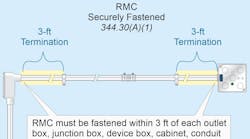Q. What is the maximum number of conductors allowed by the Code to be installed in PVC conduit?
See the answer below.
A. Raceways must be large enough to permit the installation and removal of conductors without damaging the conductors’ insulation, and the number of conductors must not exceed that permitted by the percentage fill specified in Chapter 9, Table 1 [Sec. 352.22].
When all conductors within a raceway are the same size and insulation, the number of conductors permitted can be found in Annex C for the raceway type [Chapter 9, Notes to Tables (1)].
Example Question: How many 4/0 THHN conductors can be installed in trade size 2 Schedule 40 PVC?
Answer: Four conductors [Annex C, Table C.11]
Schedule 80 PVC conduit has the same outside diameter as Schedule 40 PVC conduit, but the wall thickness of Schedule 80 PVC conduit is greater, which results in a reduced interior area for conductor fill.
Example Question: How many 4/0 THHN conductors can be installed in trade size 2 Schedule 80 PVC conduit?
Answer: Three conductors [Annex C, Table C.10]
See Sec. 300.17 for additional examples on how to size raceways when conductors aren’t all the same size.
Cables can be installed in Type PVC conduit, if the number of cables doesn’t exceed the allowable percentage fill specified in Chapter 9, Table 1.
These materials are provided to us by Mike Holt Enterprises in Leesburg, FL. To view Code training materials offered by this company, visit www.mikeholt.com/code.





